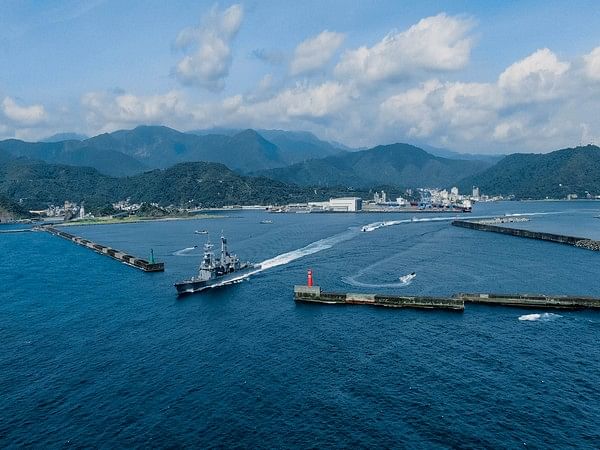Increased Chinese Naval Activity Off Sydney Coast: What Does It Mean For Australia?

Table of Contents
The Nature and Scope of Increased Chinese Naval Activity
The observed increase in Chinese naval presence off the Sydney coast involves a variety of vessels, including destroyers, frigates, and intelligence-gathering ships. While the exact frequency and duration of these activities are subject to ongoing monitoring and classification by the Australian Defence Force (ADF), reports indicate a noticeable uptick in recent years. Specific incidents, while often not publicly detailed for operational security reasons, are regularly reported in credible media outlets and defence analyses. These reports often detail the tracking of Chinese naval vessels near Australian waters, highlighting their proximity to strategically important areas.
- Types of Vessels: Destroyers, frigates, intelligence gathering ships, and support vessels.
- Frequency: Reports suggest an increase in both the number of vessels and the frequency of their appearances near the Sydney coast.
- Duration: Observed deployments range from several days to several weeks.
- Examples: While specific details remain classified, reports from the ADF and media outlets like the Australian Strategic Policy Institute (ASPI) frequently note the presence of Chinese naval vessels in Australian waters.
Potential Motives Behind Increased Chinese Naval Presence
The motivations behind this increased Chinese naval presence are multifaceted and require careful consideration. Several key factors are likely at play:
Assertion of Power and Territorial Claims
China's growing assertiveness in the Indo-Pacific region is a key driver of its naval activities. This assertiveness manifests in several ways:
- Expansion of influence: China seeks to expand its economic and political influence throughout the region, challenging existing power structures.
- Economic interests: Protecting its substantial economic interests in the region, including trade routes and resource access, is paramount.
- Strategic positioning: Establishing a stronger military presence enhances China's strategic positioning to project power and influence regional events.
Military Exercises and Training
The increased naval activity could also be attributed to routine military exercises and training operations. These activities may serve several purposes:
- Testing capabilities: These exercises allow China to test and refine its naval capabilities, including communications, coordination, and operational readiness.
- Demonstrating strength: Public displays of naval power project an image of strength and capability, aiming to influence regional perceptions and deter potential adversaries.
- Projecting power: Regular exercises in this area demonstrate China's growing military reach and its capacity to operate effectively far from its shores.
Intelligence Gathering and Surveillance
It's crucial to consider the possibility of intelligence gathering and surveillance as a significant motive.
- Espionage: Gathering intelligence on Australian infrastructure, military capabilities, and communications is a plausible objective.
- Cybersecurity threats: Naval vessels can be platforms for electronic warfare and cyber espionage operations.
- Information gathering: Surveillance activities aim to monitor Australian military movements and gather information on strategic assets.
Implications for Australia's National Security and Defence Policy
The increased Chinese naval activity has significant implications for Australia's national security and defence policy.
- Defence capabilities: Australia is investing in strengthening its defence capabilities to counter these growing challenges, focusing on areas like anti-submarine warfare and intelligence gathering.
- Allies and partnerships: Strengthening alliances and partnerships with countries like the US and Japan is crucial for maintaining regional stability and deterring aggressive actions.
- Diplomatic relations: Maintaining open channels of communication and diplomacy while firmly upholding Australia's national interests is paramount.
- Economic sanctions: While unlikely to be a first response, economic sanctions may be considered as a tool to address particularly concerning actions.
- Military response: Australia's response will likely be a multi-faceted approach focusing on defence upgrades, intelligence gathering, and diplomatic pressure.
Public Perception and Domestic Debate in Australia
Public opinion on the increased Chinese naval activity is complex and varies across the political spectrum.
- Public opinion: While there is broad awareness of the increased naval activity, public opinion ranges from concern to more nuanced views considering the geopolitical context.
- Political discourse: The issue features prominently in Australian political debates, with differing approaches proposed by various political parties.
- Media coverage: Extensive media coverage of the issue has shaped public understanding and fuelled the ongoing political debate.
- Public awareness: The level of public awareness is relatively high, prompting discussions about the appropriate response from the Australian government.
Conclusion: Assessing the Significance of Increased Chinese Naval Activity Near Sydney and Looking Ahead
The increased Chinese naval activity off the Sydney coast presents a significant challenge to Australia's national security and requires ongoing monitoring and analysis. The potential motives are complex, encompassing assertions of power, military training, and intelligence gathering. Australia’s response must be multi-pronged, encompassing enhanced defence capabilities, strengthened alliances, and robust diplomatic efforts. Continued vigilance and informed public discourse are crucial for navigating this evolving geopolitical landscape. To stay informed about developments in Chinese naval activity around the Sydney coast and its broader implications for Australia's security, we recommend consulting resources like the Australian Strategic Policy Institute (ASPI) and the Department of Defence websites. Further research into this complex issue is essential for ensuring Australia's national interests are protected.

Featured Posts
-
 After Tragedy Kendal Shows Support Poppy Atkinson Fundraiser Update
May 03, 2025
After Tragedy Kendal Shows Support Poppy Atkinson Fundraiser Update
May 03, 2025 -
 Sydney Harbour Surveillance Heightened Amidst Rise In Chinese Ship Sightings
May 03, 2025
Sydney Harbour Surveillance Heightened Amidst Rise In Chinese Ship Sightings
May 03, 2025 -
 Ghanas Mental Health System Challenges And Solutions To The Psychiatrist Shortage
May 03, 2025
Ghanas Mental Health System Challenges And Solutions To The Psychiatrist Shortage
May 03, 2025 -
 Sonys Play Station Beta Program A Closer Look At The Announcement
May 03, 2025
Sonys Play Station Beta Program A Closer Look At The Announcement
May 03, 2025 -
 Endonezya Ve Tuerkiye Ortakliklarini Gueclendiriyor Imzalanan Anlasmalarin Oenemi
May 03, 2025
Endonezya Ve Tuerkiye Ortakliklarini Gueclendiriyor Imzalanan Anlasmalarin Oenemi
May 03, 2025
